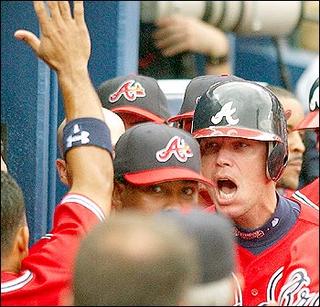
As the baseball playoffs got underway last night, the line-up of teams by and large looked the same as usual with the Yankees, Red Sox, Angels and –oh yeah, for the 14th straight year—the Atlanta Braves.
It’s hard to remember back to the days when the Atlanta baseball team came to our marketing group at Eckerd looking for potential promotional tie-ins with their sorry team of perennial losers. Now they hold the longest winning streak of any professional sports team. It hardly seems fair to someone like me whose Devil Rays finished last for yet another year in the American League.
As I read an interview between the Wall Street Journal and John Schuerholz, the Braves EVP and General Manager for all of those 14 straight playoff years, I was impressed on how the principles of building a consistently, great team is a lot like building a great brand, especially in the competitive retail world. When asked how he managed to achieve a record that any CEO would die for, Mr. Schuerholz said:
“It really turns on one significant principle, and that is surrounding yourself and filling your organization with quality people and providing them with a clear vision, an uncompromising game plan.”Notice he didn’t say put together an exciting group of characters, have regular stadium promotions, and have a memorable team slogan. Once again it’s the people, stupid! Now I know there are some that will say that it’s just a matter of getting the best players, spend a lot of money on them, and the rest happens. Schuerholz talks about the entire organization and not just the players and coaches. Winning brands are the same. It’s not just having great merchants, great marketers, and dedicated operations people. It’s having everyone from the distribution centers to the sales floors understanding the brand vision and then executing it better than the store across the parking lot.
I’ve talked about the 5 steps of totalbrandintegrationÒ that we have developed to get everyone to live up to the brand everyday. It’s not coincidental that Schuerholz’ 5 Tips on Transforming a Culture of Losing are very similar to the branding principles:
· Gather everyone, communicate the plan and preach it daily. How often we forget to market our brand to our own people as effectively and as consistently as we do to our customers.
· Constantly remind them that it works. Just sending out a video and a newsletter is not gong keep the brand top of mind. It has to be talked every day at every store. The store managers are the team leaders.
· Don’t be afraid to get rid of the people who don’t buy in. There is no shortage of the right people for the job even at store level. You have to go after the right ones and recognize the attributes of your best people and replicate them. Let the rest of them go on the free agent list.
· Make the lowest level employees feel as important to success as the top-level executives. The people on the floor or on the phone in customer service are the one’s who have the interaction with the customer and make the brand a reality (or a false promise).
· Show trust in everyone to do their jobs well. We all talk about empowerment as much as we do about branding. The key is to living it with great people who understand what the company is all about.
In the coming days, we will hear a lot of interviews with the winning players and managers and they will likely say something to the effect that “it’s really a team effort” that makes winning possible. Winning consistently and having a preferred brand day-in/day-out, certainly is a team effort and the brand is the personification of the team and the vision.
Now back to the game.









